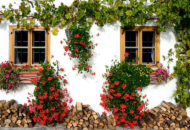Mistakes to Avoid When Taking Care of Your Home GardenMistakes to Avoid When Taking Care of Your Home Garden
Taking care of your garden gives you a sense of responsibility. It can also be a therapeutic exercise when things are not going well for you elsewhere. Nevertheless, most people succumb to common mistakes unknowingly. You must be on the lookout for ways that might destroy a precious asset in your home. Gardens derive their beauty from the meticulous decisions you make about the plants’ care and the overall management of the space. The following are the mistakes to avoid when taking care of your home garden.
Never Plant Without a Plan
 You should not put new plants or transplant in your garden without a plan as that is a recipe for disaster. You must always step back for a moment and evaluate your options and your needs in the garden. Plants need different climatic and soil conditions for them to survive.
You should not put new plants or transplant in your garden without a plan as that is a recipe for disaster. You must always step back for a moment and evaluate your options and your needs in the garden. Plants need different climatic and soil conditions for them to survive.
Furthermore, the space around the garden will support or hinder the growth of some plants in as much as you may prefer them to others in your area. These restrictions to ideal plant growth require you to plan the best way to meet your needs and have plants that will survive the specific garden conditions in your home.
Do Not Use Too Much Fertilizer
Fertilizer helps plants get the nutrition needed for fast growth. There is a limit to the amount usable and most homeowners fail to educate themselves on this threshold. Consequently, they apply the same amount for all plants even the ones that only need a fraction of the nutrition content.
Furthermore, the soil might have fertilizer remnants from the previous application. You must have a way to measure the content of the soil’s nutrient before determining the type and volume of fertilizer to add.
Avoid Excessive Water Application
Plants need water to the point called “wetting point,” which implies the level at which the soil no longer holds the water but drains it. Keeping the plants fed and giving them sufficient water is important. However, if you notice the water is not sipping into the ground anymore then you already reached and surpassed the wetting point of the medium used to grow your plants.
Different soils have different water retention capacities. Therefore, they come with varying points of wetting. Too much water causes plants to die because they cannot get their nutrients and they tend to lack sufficient oxygen. The organisms living in the soil also die when water is too much.
Do Not Fail to Offer Sufficient Sunlight
 Plants require sunlight for photosynthesis, and this natural arrangement must be in place in your garden for them to thrive. Some temperate plants will tolerate fewer hours of sunlight while tropical plants need at least six hours of sunlight daily.
Plants require sunlight for photosynthesis, and this natural arrangement must be in place in your garden for them to thrive. Some temperate plants will tolerate fewer hours of sunlight while tropical plants need at least six hours of sunlight daily.
If you are planting in shades, then you must know these requirements and consider them appropriately according to the needs of your plants. Some indoor plants can thrive outside in shaded areas because they require fewer sunlight hours overall.
Conclusion
Follow these precautions for your garden to thrive for years into the future. Always remember to plan before making any changes. Keep things clean and organized to avoid confusion and to make it easy for others to take care of the garden too.…

